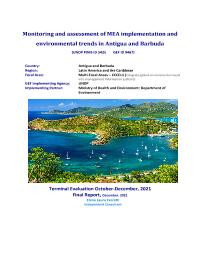
Monitoring and assessment of MEA implementation and environmental trends in Antigua and Barbuda
Completedon 31 Jan, 2022
Evaluation Plan
Planned End Date
Jan 2022
Evaluation Type
Project
Management Response
Yes
Evaluation Budget
$20,000
Evaluation Title
Monitoring and assessment of MEA implementation and environmental trends in Antigua and Barbuda
Atlas Project Number
00099053
Plan Period
Status
Completed
Type
Project
Plan Date
31 Jan, 2022
Completion Date
31 Jan, 2022
Budget
$20,000
Expenditure
$18,240
Source of Funding
UNDP project budget
Management Response
Yes
Quality Assessment
Yes
Joint Programme
No
Joint Evaluation
No
GEF Evaluation
Yes
Expand
Stakeholders
Ministries of Climate; Physical Planning; Communication; Works; Social Development; Housing and Community Development; Gender Affairs; Economic Planning; Emergency Management agencies; Health and Well-being; Sustainable Development; Tourism; Energy
Countries
Barbados
Atlas Project Number
00099053
Plan Period
Status
Completed
Type
Project
Management Response
Yes
Plan Date
31 Jan, 2022
Quality Assessment
Yes
Completion Date
31 Jan, 2022
Joint Programme
No
Joint Evaluation
No
Budget
$20,000
GEF Evaluation
Yes
Expand
Expenditure
$18,240
Stakeholders
Ministries of Climate; Physical Planning; Communication; Works; Social Development; Housing and Community Development; Gender Affairs; Economic Planning; Emergency Management agencies; Health and Well-being; Sustainable Development; Tourism; Energy
Source of Funding
UNDP project budget
Countries
Barbados
Output 3.1 Institutional systems to manage multi-dimensional risks and shocks strengthened at regional, national and sub-national levels
Goal 15. Protect, restore and promote sustainable use of terrestrial ecosystems, sustainably manage forests, combat desertification, and halt and reverse land degradation and halt biodiversity loss
15.1 By 2020, ensure the conservation, restoration and sustainable use of terrestrial and inland freshwater ecosystems and their services, in particular forests, wetlands, mountains and drylands, in line with obligations under international agreements
1: Environment


